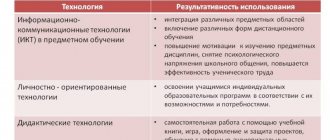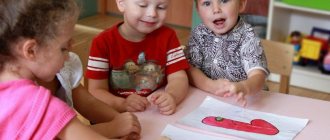TRIZ pedagogy: how to develop a child’s invention and creative thinking
This is the mysterious word "TRIZ"
TRIZ is a theory for solving inventive problems.
The author of the theory was the Soviet writer and engineer Heinrich Altshuller (1926-1998). He hoped to bring invention to the “rank” of science and for this he independently derived the laws for the development of technical thought. One of these laws was the statement that “every invention is a resolution of a contradiction.” For example, shoes should have laces, because laces are great for securing shoes on your feet and do not lose their properties like Velcro. But shoes should not have laces, because it is tiresome to tie them every time, and small children are not able to handle the laces on their own. Ordinary people have to choose one thing: sacrifice either reliable fixation of the feet or convenience. The inventor sees the problem and fixes it. As a result, an invention appears - silicone lace clips. These clips combine the fixation of regular laces and ease of use, since they do not need to be constantly tied.
But why do we need TRIZ at all...
...after all, proven experiments, theoretical and applied branches of science have long existed for scientists?
Altshuller did not agree with the old methods; he believed that the trial and error method was not satisfactory. Scientists spend dozens of years waiting for a successful idea or theory, and then spend the same number of years on research and experiments. And if you use the rules of ingenuity, then even ordinary schoolchildren can easily cope with difficult technical problems.
So, TRIZ pedagogy helps to study the principles of solving complex creative problems using Altshuller’s laws and developments. But why study any additional developments if children have been taught to solve problems at school for a long time. Yes, this is true, but one important “BUT” should be taken into account - school tasks are far from everyday tasks. In life’s dilemmas, all the information is not always “given”, there is nowhere to look for answers, and there may be more than one correct solution. Faced with an atypical problem, former school medalists find themselves at a dead end.
From 1946 to 1971 G.S. Altshuller examined more than forty thousand patents, classifying inventive solutions into five levels of ingenuity. Forty techniques have been identified that help inventors live up to their name. The first TRIZ classes began in 1948, and until 1970, teaching took place mainly in experimental seminars. In the early 70s, special engineering schools began to open throughout the country, but the project was soon closed. Seminars on TRIZ continued, but no longer at the school level.
In the 90s, foreign scientists became interested in TRIZ. In 1999, the International TRIZ Association was created, including organizations from Russia, the USA, Israel, Japan and France. TRIZ methods and laws are used by NASA, Boeing, Samsung, General Electric.
Technology of creative thinking (binding)
This book is a response to the challenge of the time about the need to understand the nature of creativity and teach a person to manage his intellectual activity. Developing the capabilities of the famous theory of inventive problem solving (TRIZ), created by G.S. Altshuller, the authors developed a unique methodology for the formation of creative thinking as a conscious, purposeful and controlled process. The proposed TRIZ tools allow you to successfully solve problems of any degree of complexity that arise in production, economics, management, education, and marketing.
Buy
TRIZ tasks
In order for children not to fall into a stupor when solving unusual and atypical problems, they need to be constantly engaged.
Such non-standard problems are called “open”. In his interview with the online publication “Mel,” TRIZ teacher Anatoly Gin gives an example of such a creative task in a physics lesson that can attract students and make them think outside the box: “The teacher draws a hill, a tree, a cow on the board: “A cow is grazing on a hill. The weather is rainy, clouds, thunder and lightning. After another blow, the cow falls dead. What happened? Children put forward hypotheses, the class discusses them. And then the teacher says: “Today we will study electromagnetic induction. The first one to guess how it is connected with the death of the cow will receive a high five.” The problem is structured in an interesting, non-trivial way, stimulates the student’s interest, and also forces him to look for an unusual approach to the solution. And similar problems can be selected for any subject, however, creating such conditions also requires a creative approach from the teacher.
It is necessary to find a “golden mean” (with which in our country, for some reason, we always have problems) - standard tasks that reinforce the topic covered must be combined with creative tasks that stimulate students to look for different approaches to the problem posed.
Here are some TRIZ problems, try to solve them.
No windows, no doors...
Question: Which direction does the bus go?
Answer: The doors are located on the side that we cannot see. Therefore, the bus goes to the left. For countries where traffic is on the left, the answer is the opposite.
Runs, murmurs, worries...
Conditions: To resolve problems with the water supply, workers excavated part of a metal pipe laid underground through which water flows. However, in order to work further, it is necessary to understand in which direction the water flow is moving. It was not possible to determine the direction of movement, either when they knocked on the pipe, or when they tried to determine something by ear.
Question: how to determine in which direction water flows through a pipe without violating the seal of the latter (you cannot cut, drill, etc.)?
Answer: It is forbidden to influence the pipe, but it is allowed to influence the water. You should heat the water in the pipe in one place (the pipe is metal!) and, having retreated some distance from this place, monitor in which direction the pipe also becomes warmer. Wherever the warm section of the pipe is, the water moves in that direction.
Secret package
Conditions: You want to send your loved one a parcel with expensive jewelry. In this case, the only way is to use the mail. You can put any number of locks on the parcel. Let’s say that no one can open a lock without a key, just like opening a parcel. But under no circumstances do you want to risk sending keys by mail.
Question: How can you be absolutely sure that your loved one will receive the gift (and be able to open the package)?
Answer. Having received a package without a key, the girl will not be able to open it, but she will be able to lock it with her lock and return it. Having received a package with two locks, you remove your lock and return it to the girl. As a result, the girl receives a gift, but the keys are not sent anywhere.
Boat, wolf, goat, cabbage
The popular problem of a peasant transporting his property has more than one solution. Find at least one.
Conditions: The peasant needs to transport a wolf, a goat and a cabbage across the river. But only a peasant can fit in the boat, and with him either one wolf, or one goat, or one cabbage. But if you leave a wolf with a goat, then the wolf will eat the goat, and if you leave a goat with cabbage, then the goat will eat the cabbage.
Question: How did the peasant transport his cargo?
Answer 1: Transportation should start with a goat. A peasant transports a goat and leaves it on the other side. He returns and takes the wolf, which he also transports to the other shore, where he leaves it, but he also takes the goat and takes it back to the first shore. Here he leaves her and transports the cabbage to the wolf. Then, returning, he transports the goat, and the crossing ends safely.
Answer 2: First, the farmer transports a goat. However, this time he takes not the wolf, but the cabbage. He takes it to the other bank, leaves it there and returns the goat to the first bank. Then he transports the wolf to the other side, returns for the goat and again takes it to the other side. In this case, the number of flights (seven) is exactly the same as in the first solution.
What else should I read?
- What is modular training?
- Where is a school without classrooms, offices and smartphones?
- Virtual reality to transform teaching and learning
- What competencies do modern schoolchildren need, and is school developing them?
- Breadth or depth? Extensive and intensive education
TRIZ for everyone
The challenges are not limited to educational institutions. Difficulties and problems await us everywhere that need to be solved. Either you need to open the office door when the keys are left at home, or the phone goes off at the wrong time, but you need to make a very important call, or the workers have blocked the road to the house and you have to find an alternative way to return to your home walls.
People who enthusiastically practice solving problems using TRIZ see in every trouble not a problem, but a task. They formulate conditions, establish data and contradictions, set a goal and select resources for a solution. For a person who practices performing certain actions, the method of “inertia”, “full hand”, works. Likewise, for people who are often accustomed to analyzing data and looking for resources, the necessary methods open up much faster than for a person who is accustomed to acting “by the rules.”
You can train the TRIZ way of thinking from an early age. For young children, you should set easy tasks that require a different approach, analyze solutions together, and come up with an alternative. For example, for a child under four years old, you can use the technique from the cartoon “38 Parrots”. The baby has just begun to master counting and may not yet know all the numbers that make up his growth. Try measuring your child's height in other objects. For example, how tall will he be in writing pens? What about dolls or cars?
From the age of five to seven, you can already begin to look for solutions to open problems from books and slowly introduce them to the basic principles of TRIZ.
Classic TRIZ, although developed for engineers, is able to interest older schoolchildren and adults.
But where can you learn to solve problems using TRIZ?
Practicing TRIZ solutions is quite easy. There are open services for TRIZ, for example, the 4BRAIN service or the free course Sharpener for the Mind. You can use ready-made open tasks from books (for example, D. Chernyshev “What to do in the evening with your family at the dacha without the Internet” or Y. Tamberg “How to teach a child to think”). Also, A. Gin’s book “Triz-pedagogy. “Teaching to think creatively” with a list of basic methods and tasks for children.
In general, as they say, if there is a desire, there will be opportunities.
Remember, the more your child can do and the more he develops, the happier and more successful his future life will be. #ADVERTISING_INSERT#
Master class “TRIZ technology techniques in primary school”
Master class “TRIZ technology techniques in primary school”
(slide 1)
The purpose
of the master class:
to reveal the essence of TRIZ technology techniques.
Expected Result
: awareness by the pedagogical audience of the effectiveness of using TRIZ technology techniques.
Decor:
computer presentation.
Duration:
15 minutes.
Progress of the master class
1. Introductory part (1 minute).
Dear colleagues! I am glad to welcome you to my master class. I hope that this meeting will be useful and productive for everyone. The purpose of my master class: to reveal the essence of TRIZ technology techniques. (slide 2)
2. Theoretical part with presentation (6 minutes).
Modern education should be carried out in such a way that students awaken interest in knowledge, increase the need for a more complete and profound assimilation of it, and develop initiative and independence in work. In the learning process, students must not only acquire knowledge, skills and abilities, but also develop their cognitive abilities and creative powers. (slide 3)
To do this, it is necessary that in school a special place is occupied by the use of technologies that ensure the active participation of each student in the lesson, increase the authority of knowledge and the individual responsibility of schoolchildren for the results of educational work. [1]
The psychological characteristics of younger schoolchildren, their natural curiosity, responsiveness, special disposition to learn new things, readiness to accept everything that the teacher gives, create favorable conditions for the development of cognitive activity. To activate cognitive activity and increase motivation for learning in different lessons, I effectively use TRIZ technology methods. (slide 4)
TRIZ technology is a pedagogical direction whose goal is to teach creative problem solving skills.
TRIZ is a theory for solving inventive problems
, which teaches to “open consciousness”;
This is the science of getting rid of stereotypes. The idea of creating the TRIZ program belongs to G. S. Altshuller. (slide 5) Genrikh Saulovich Altshuller
(10/15/1926 - 09/24/1998) (pseudonym - Genrikh Altov) - famous
scientist, inventor, writer.
The goal of TRIZ
(slide 6 )
is to develop creative thinking in children, i.e. education of a creative personality prepared for stable solution of non-standard problems in various fields of activity. The main goal that TRIZ teachers set for themselves is not just to develop children’s imagination, but to teach them to think systematically, with an understanding of the processes taking place.
As a result of learning, children develop a positive emotional attitude towards lessons (slide 7)
:
- cognitive activity and interest increases;
- children's answers become non-standard, liberated;
- Children's horizons broaden, a desire for novelty and imagination appears;
- speech becomes much more figurative and logical;
- Thanks to the use of TRIZ technology in the classroom, personality harmonization occurs: the left hemisphere develops when analyzing contradictions and finding ways to solve a problem, and the right hemisphere retains the creative process, imagination and fantasy. [1]
The TRIZ methodology can be called a school of creativity, its motto is creativity in everything: in posing a question, in methods of solving it, in presenting material.
In lessons using TRIZ, knowledge, skills and abilities are not transmitted from the teacher to the children, but are formed as a result of independent work with information. [3]
A large place in TRIZ education is occupied by students’ independent creative activity aimed at obtaining a new result. The productive activity of primary school students is not so much aimed at solving technical educational problems, but at solving and inventing what is more real and closer to them: inventing a riddle, expressing an original hypothesis, composing a fairy tale, metaphor, proverb, “yes-no”; invent an outdoor game, come up with a new property of an object and its practical application, propose a solution to a problem that has arisen in the classroom, invent and make a new toy, etc. [5]
Let's get acquainted with some TRIZ pedagogy techniques (slide 8 )
, which allow you to turn a lesson into an exciting journey, turn a student not into an object of learning, but into a subject of this learning, allow him to create and fantasize, allows him to form creative thinking, without which a person will not be able to exist with dignity in the future society, will not be able to respond sensitively to the rapidly changing circumstances of our society.
- Yes-no method
- Synectic method
- Focal object method
- Methodology for essays based on paintings
- "Morphological analysis"
- Model "System elevator"
- Inventive problem solving mechanism
- System operator method
- Model “Create a passport”
- Modeling processes and phenomena in nature and technology using the little people method
- Writing riddles
- Model “Element – attribute name – attribute value”
3. Practical part (7 minutes).
1) “Yes-No” technique
(slide 9)
Using the “Yes-No” technique (a method of narrowing the search by asking questions that can be answered “yes-no”) to formulate a lesson topic or review the material covered in a mathematics lesson. (slide 10)
— I thought of the name of a geometric figure. It is among the figures on the slide. Having guessed it, you can find out the topic of our lesson. I will give you hints by answering your questions, but I can only answer “yes” or “no.”
2) Method “Cause - Fact - Effect”.
(slide 11)
Purpose of the reception:
learn to determine a cause-and-effect relationship and carry out a mini-research. To solve a logical chain, only one of its components is proposed. Students select a reason (or reasons) for a given fact and determine its consequences, or look for a fact and a consequence following from it for a given reason.
An example of using the technique
(slide 12)
Reason
| Literary reading lesson Lesson topic: Folk tales. (Tale "Turnip") | |
| Fact | Consequence |
| Grandfather called grandma... | |
| The turnip grew big and big |
3) Technique “Good - bad” (slide 13) The purpose of the technique:
to activate the mental activity of students in the lesson, to form ideas about how the contradiction works. The technique forms cognitive skills: students consciously and voluntarily construct verbal statements; establish cause-and-effect relationships; build logical chains of reasoning and provide evidence.
An example of using a technique
in a lesson on the surrounding world on the topic “Weather”.
| The teacher asks the situation: “One of the natural phenomena is rain. Find the pros and cons of this phenomenon.” The class is divided into two teams. One is looking for the pros, the other is looking for the cons. An example of the result of the work. |
4) Algorithm for writing riddles
(slide 14)
Riddle about a comb. What is it: like a fence, but you can’t climb over it, like a saw, but it doesn’t cut, like grass, but it doesn’t grow?
5) “Backpack” technique (without slide)
Purpose of reception:
teach students to understand and record their progress in their studies.
This technique is more often used in lessons after studying a large section.
You can use a picture that moves from one student to another. Each student talks about what he puts in this backpack (acquired knowledge, skills on this topic).
4. Reflection.
Conclusions. (1 minute). (slides 15-17)
The master class has come to an end. I think everyone understood the essence of using TRIZ techniques. The main attractiveness of using TRIZ techniques is that they are all interesting for the student, form cognitive activity, develop all thinking operations, all types of universal learning activities. They help to find solutions to a problem situation, reflect on the material covered, develop creative and logical thinking, and evaluate their work. (slides 18-19)
Bibliography:
- Altshuller G.S. Paints for fantasy. Prelude to the theory of development of creative imagination. // Chance for adventure. /comp. Selyutsky A.B. – Petrozavodsk, 1991. p. 88
- Didactic games for the development of children's creative imagination / comp. Nikashin A.I. – Rostov-on-Don, 1991 p. 23-47
- Murashkovska I.N. When I become a wizard. //Cognition: inf. – method. collection for teachers and students, issue 5. – Riga, 1993. p. 102-106
- Murashkovska I.N. Games for TRIZ classes with young children.// “Pedagogy + TRIZ”: collection. articles for teachers, educators and education managers, issue 2. - Gomel: IPP "Sozh", 1997. p. 12-13
- Strauning A.M. Rostock. TRIZ-RTV program for preschool children. – Obninsk, 1995. p. 55-60
- https://vichta23.ru/2019/02/ispolzovanie-tehnologii-reshenija-izobretatelskih-zadach-triz-na-urokah-v-nachalnoj-shkole/



